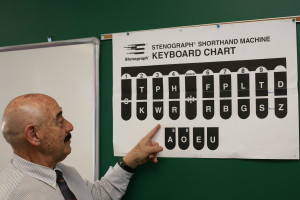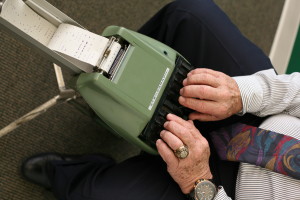At 28, Leslie Smith juggles three part-time jobs ”“ waitress, food store clerk, ophthalmologist”™s Saturday assistant ”“ while preparing for a new career. Her ambition brings her across the Tappan Zee Bridge from New Jersey”™s Bergen County into downtown White Plains five mornings each week to learn what she calls “a totally new language” at the New York School of Court Reporting and Career Institute.
“It”™s a challenge,” Smith said after four hours of classes one recent morning in the school”™s fifth-floor office at 34 S. Broadway. “It”™s like they”™re teaching you a new language.”
Stuart M. Auslander, the White Plains school”™s founding director, said in teaching he stresses “the three Ps: practice, patience and perseverance.” Students who follow those succeed and go on to land jobs as court or freelance reporters, often with the help of the school, which has a 100 percent placement record for graduates entering the job market, he said. “It”™s kind of a combination of learning a musical instrument and learning a foreign language,” he said.
It”™s a phonetic language learned on the 22 keys of a stenographer”™s shorthand machine to the accompaniment of a teacher”™s dictation. At first glance, the oddly spaced and combined letters resemble tiny chicken tracks on the machine”™s paper scroll.

“What I tell my students,” said retired court reporter Herb Fabel, “is when you finish writing, your paper should like someone sneezed on alphabet soup and it landed there.”
To qualify for the state”™s Civil Service eligibility list for court reporters, candidates must apply that phonetic method to accurately record English speech at the rate of 225 words a minute. To graduate from the New York School of Court Reporting, Smith and her fellow students must achieve 95 percent accuracy on dictation tests.
Smith previously studied to be a medical assistant and worked at a full-time job in an ophthalmology practice, but reached a dead end in that career. “I didn”™t have anywhere up to go,” she said. “You hit the top and you”™re, ”˜OK, this is not”™…”
She considered nursing studies, but a friend of her parents, a court reporter for 20 years, insisted she would excel in that occupation. Last year, Smith attended an open house at the school in White Plains and began taking courses in April. She hopes to graduate ”“ the school produces about 10 graduates each year ”“ in two years, the typical length of studies at a school in which day and night students can set their own pace.
Paying $580 a month in tuition, Smith expects her schooling will cost about $13,000. (The school calculates average tuition for full-time day students at $13,920 and at $13,680 for part-time night students, said instructor Christine Soldan.) She expects to start out as a freelance reporter, recording depositions for lawyers. “I don”™t mind working in a court at all either,” she said. “That sounds good to me.”

In the state of New York, the average salary for a court reporter or a closed captioner ”“ the computer software-supported addition to the traditional stenographer”™s work ”“ is $87,000, according to the U.S. Department of Labor. In state Supreme Court, salaries start in the $80,000 range and rise to six figures for court reporters. Jobs in the field are expected to grow 25 percent by 2016, “mainly because of closed captioning,” Auslander said. “It”™s blossoming.”
Court reporters supplement their base salaries with sales of case transcripts, which they own as independent contractors. Those earnings amount to a minimum of $20,000 to $30,000 a year, he said.
Auslander spoke by phone from his home in Florida, where he retired after a 35-year career that included 28 years as senior court reporter in state Supreme Court in Westchester. His magnum opus: the transcript of the second trial in 1992 of Scarsdale teacher Carolyn Warmus for the murder in Greenburgh of her lover”™s wife. The document ran to more than 18,000 pages, the longest on record in Westchester. It ended with a guilty verdict.
Auslander the previous year had opened his court reporting school in a North Broadway office in North White Plains. “I never had aspirations to do that,” he said. “I was a busy court reporter. I did it to fill a void” when a vocational school in White Plains where he and other court reporters taught was cited by the state for illegally disbursing federal student loans in its court reporting program. “Someone had to do it,” he said.
“This field is a well-kept secret. People don”™t know about it,” Auslander said. Like Smith, most students hear of it through family connections.
Fabel, whom Auslander wooed out of retirement after a 40-year career in state and Army courts, followed his older brother into the field after graduating from Port Chester High School in 1958. A few blocks from the school”™s downtown office, Fabel”™s septuagenarian brother, Bernard, runs Judicial Reporting Service Inc, a court reporting agency, at 120 Bloomingdale Road. His business partner is Linda Fabel, Herb”™s former wife. They met in court reporting school in New York City.
Auslander”™s daughter Kim was a journalism major in college. She too gravitated to a career in court reporting, first in New York and now in Tampa, Fla.
“You see it in the movies ”“ every court scene has a court reporter,” Fabel said. “But no one growing up says, ”˜I want to be a court reporter.”™”
“The best part about this profession is you can take this anywhere in the country and you can do it at any age,” he said.
“The field ”“ every day is different. When you think you”™ve heard it all, you hear something else. ”¦The education ”“ intellectually, you grow,” Fabel said. In medical malpractice cases, for example, “You really learn about the medical field. I find medical the most interesting” of court cases.
Court reporting is also recognized as one of the nation”™s recession-proof jobs, Auslander said. While the school has seen declining enrollment in recent years, “Ironically, in a bad economy, many times this field prospers” as the demand for court reporting services rises with the higher volume of lawsuits.
“In times like this,” said Fabel, “when money is tight, people are looking for money. You”™re in a litigious society. The worse the economy is, the better we are.”
Though digital technology has enhanced the court reporter”™s services with closed captioning and rapid translations on monitors of the reporter”™s shorthand, instructors at the school in White Plains do not fear that their human kind will ever disappear from the judicial system.
“Nobody wants the court reporters replaced ”“ lawyers, judges ”“ because actually we help them a lot,” Soldan said.
“Forty years ago when I started, they said, ”˜You”™re going to be replaced by machines,”™” Fabel said. But in a courtroom, “There are so many distractions” to disrupt clearly audible testimony and statements by lawyers and judges, he said. Coughing, doors slamming, papers rustling, secretaries whispering to judges, and witnesses speaking in faulty or unintelligible English can impede the spoken case record. “Once it”™s gone, it”™s gone forever,” he said.
“There”™s no electronic machine that can say, ”˜I didn”™t get that,”™ whereas you have a human who can say, ”˜Can you repeat that?”™”
The New York School of Court Reporting will hold its spring open house on March 8, starting with an informational session at 10 a.m.



















Comments 2